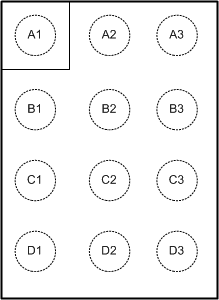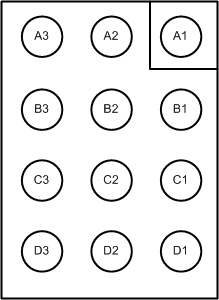SNVS594G December 2008 – April 2016 LM3555
PRODUCTION DATA.
- 1 Features
- 2 Applications
- 3 Description
- 4 Revision History
- 5 Pin Configuration and Functions
- 6 Specifications
-
7 Detailed Description
- 7.1 Overview
- 7.2 Functional Block Diagram
- 7.3 Feature Description
- 7.4 Device Functional Modes
- 7.5 Programming
- 7.6 Register Maps
- 8 Application and Implementation
- 9 Power Supply Recommendations
- 10Layout
- 11Device and Documentation Support
- 12Mechanical, Packaging, and Orderable Information
Package Options
Mechanical Data (Package|Pins)
- YZR|12
Thermal pad, mechanical data (Package|Pins)
Orderable Information
5 Pin Configuration and Functions
YZR Package
12-Pin DSBGA
Top View

YZR Package
12-Pin DSBGA
Bottom View

Pin Functions
| PIN | I/O | DESCRIPTION | |
|---|---|---|---|
| NUMBER | NAME | ||
| A1 | PGND | — | Power ground |
| A2 | SGND | — | Signal ground |
| A3 | VIN | I | Input voltage pin of the device. Connect input bypass capacitor very close to this pin. |
| B1 | SW | — | Inductor connection |
| B2 | TORCH | I | Torch pin. Driving this pin high enables torch mode. |
| B3 | IND | O | Red indicator LED current source. Connect to RED LED anode |
| C1 | VOUT | O | Boost output. Connect output bypass capacitor very close to this pin |
| C2 | STROBE | I/O | Strobe signal input pin to synchronize flash pulse in I2C mode. This signal usually comes from the camera processor. In simple logic mode this pin, when tied to a voltage rail through a pullup resistor indicates the number of LEDs in the system. |
| C3 | I2C / EN | I | I2C / EN-logic selection. High = I2C mode, Low = simple logic mode. |
| D1 | VLED | O | LED current source. Connect to the anode of the flash LED. One or two LEDs can be connected in series. |
| D2 | SDA / EN2 | I/O | EN2 signal pin in simple logic mode. I2C data signal in I2C mode. |
| D3 | SCL / EN1 | I | EN1 signal pin in simple logic mode. I2C clock signal in I2C mode. |